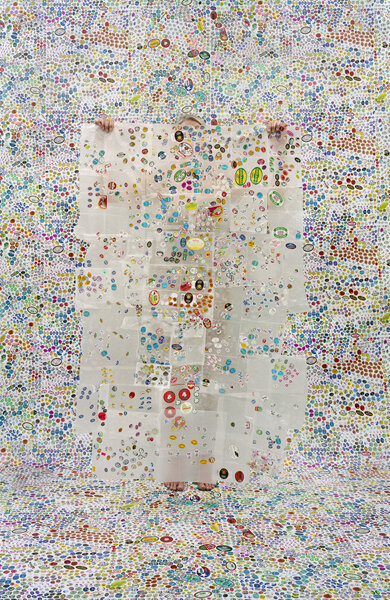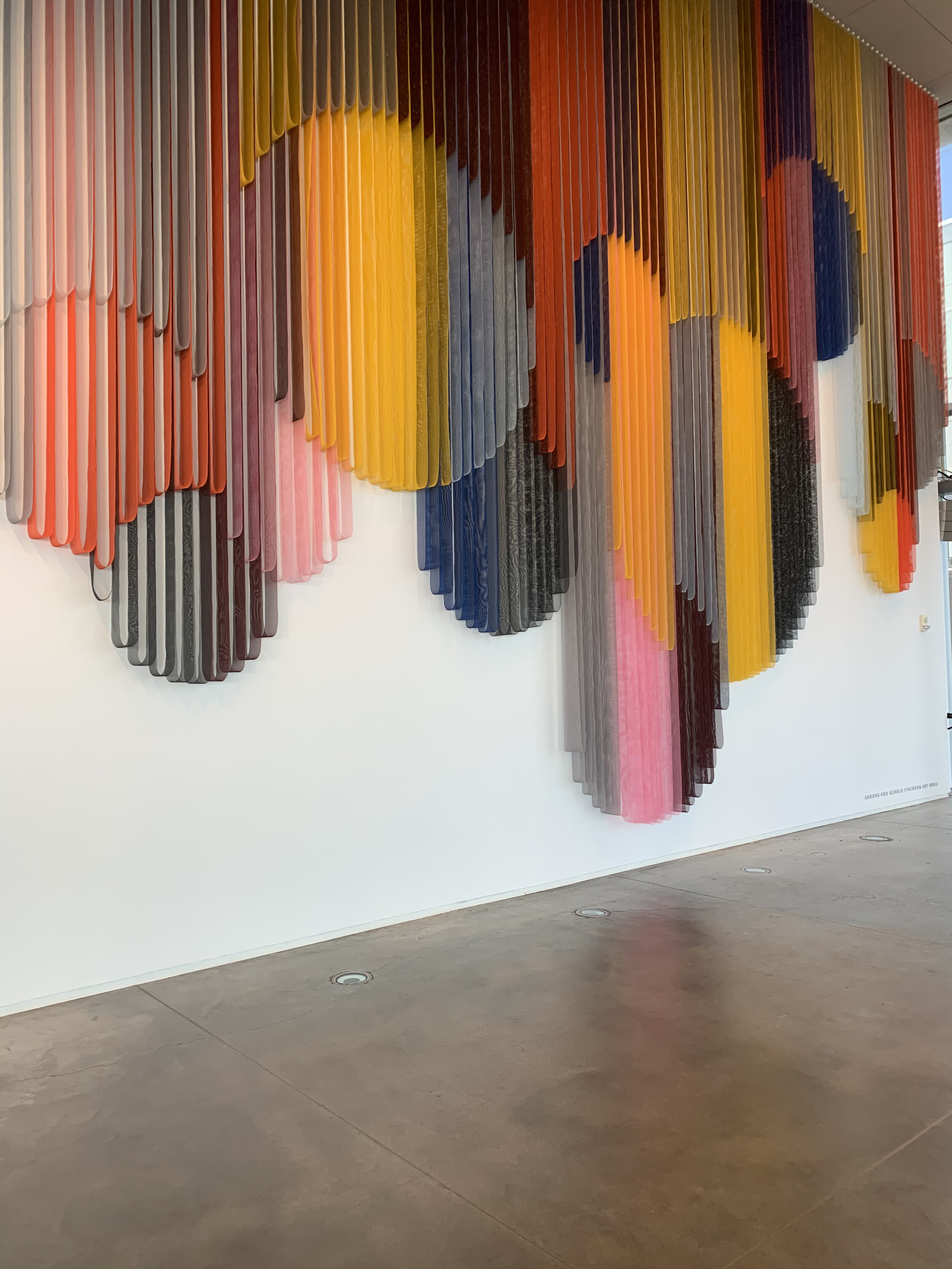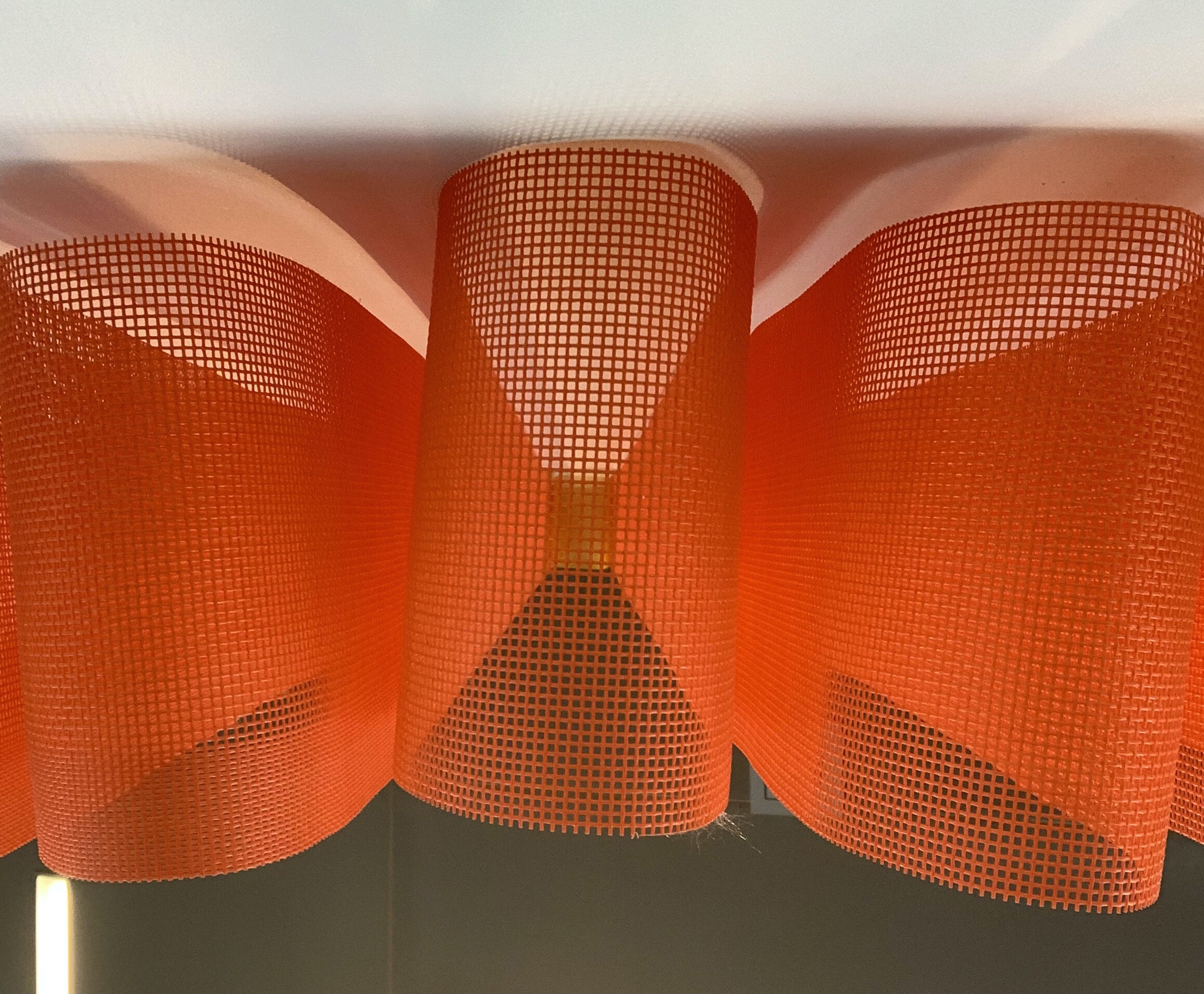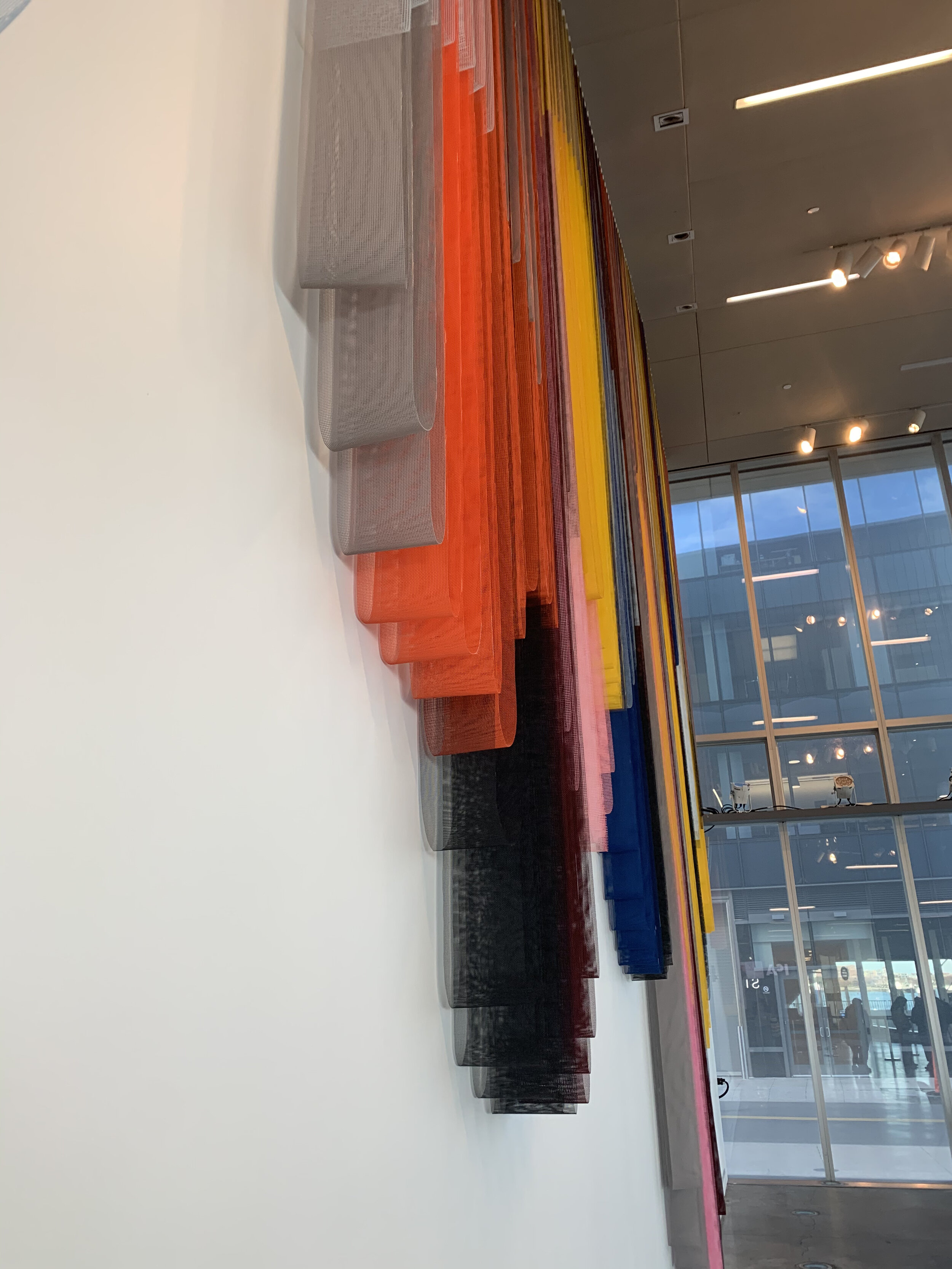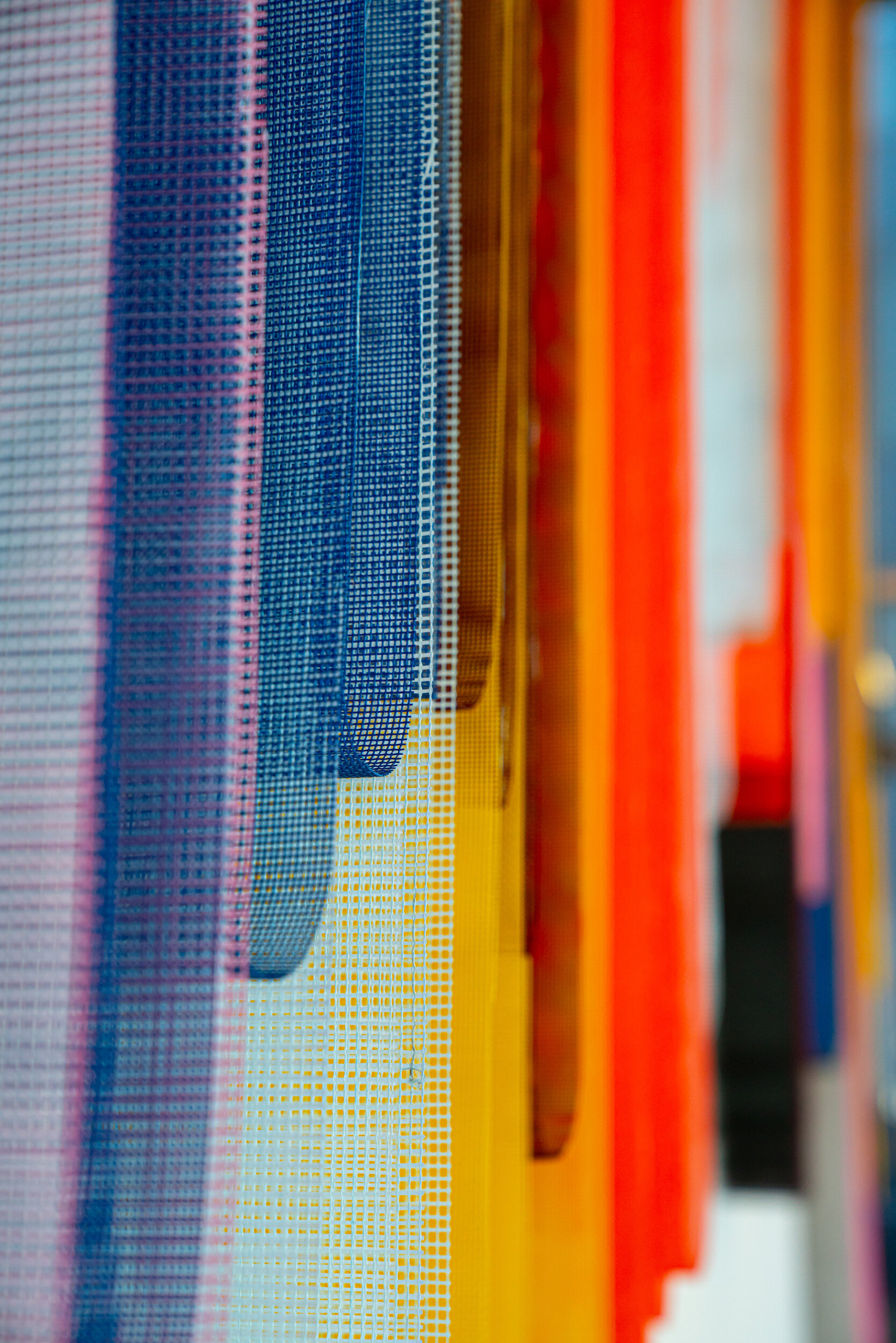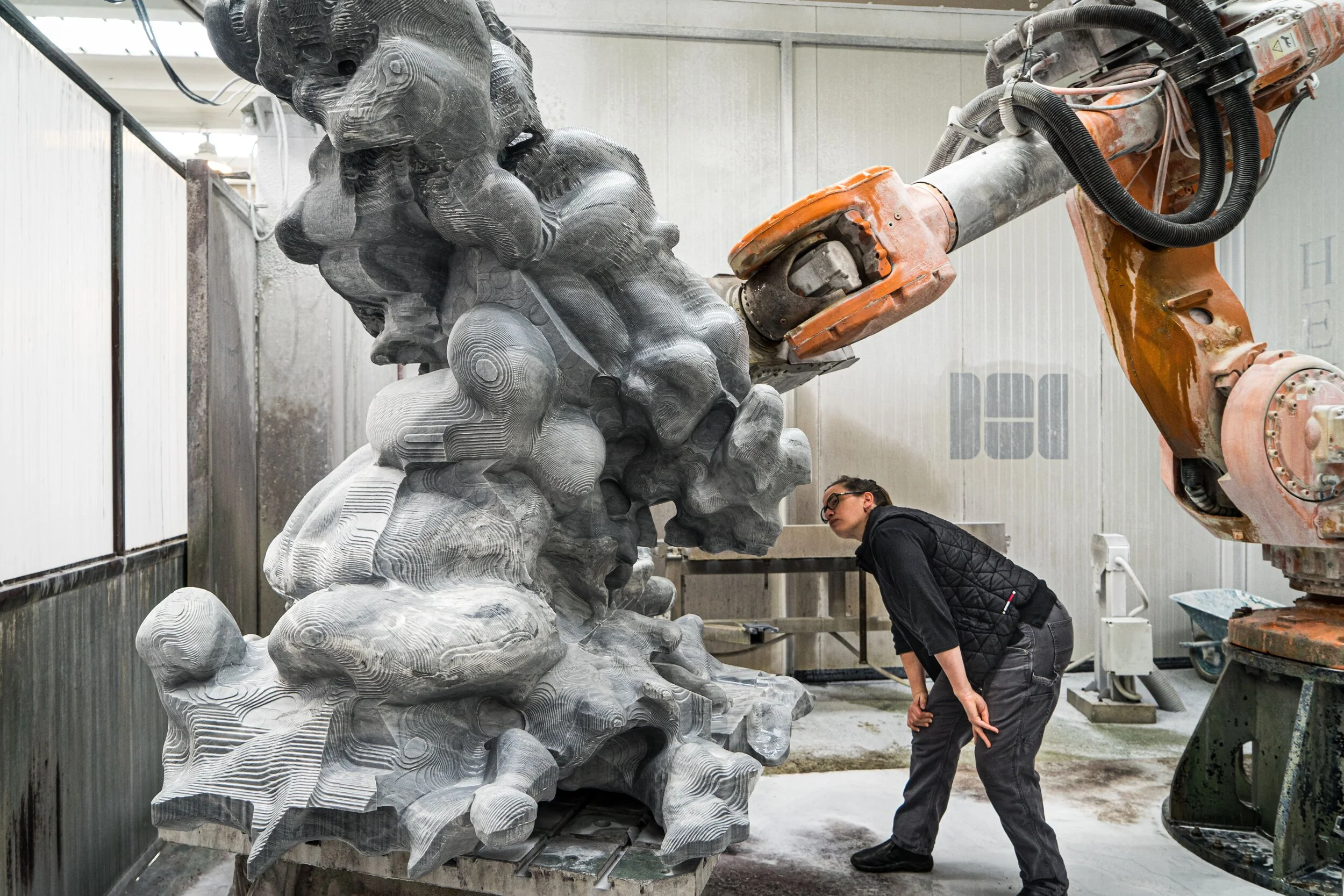Undaunted: Eva LeWitt's Fearless Embrace Welcomes Us Back
Eva LeWitt’s open-armed installation Untitled (Mesh Circles), 2021 is the invitation we’ve been waiting for to “get back out there.” After months of confinement, the sprawling, kaleidoscopic sculpture created for the Fineberg Art Wall in the lobby of the Institute of Contemporary Art/ Boston offers an unapologetic, optimistic embrace, welcoming visitors back to the museum and back to city life.
How did Peaches and Herb put it in Reunited? “We both are so excited cause we’re reunited, hey hey.” That’s how I felt in the presence of LeWitt’s work during my first visit back to the ICA after its second COVID closure: excited, reunited, hey hey.
Untitled (Mesh Circles)’ grand scale (the work is 47 feet long by almost 40 feet high) and bold, unexpected colors announce to the city that beauty is back and everyone is welcome.
Eva LeWitt,Untitled (Mesh Circles), 2021. Installation view,Eva LeWitt, the Institute of ContemporaryArt/Boston, 2021. Courtesy the artist and VI,VII, Oslo, Norway. Photo by Ernesto Galan.©Eva LeWitt
After the most isolating and painful year in memory, people need a warm and uncomplicated welcome. Simplicity and sincerity are the order of the day. Though grand in scale and ambitious in execution, Untitled (Mesh Circles) is in some ways incredibly simple: created from just one material, in a meticulous geometric arrangement.
According to Jeffrey DeBlois, the ICA’s Assistant Curator and Publications Manager who worked closely with LeWitt on the installation, “it’s colors, simplicity, abstraction. People can take the art on its own terms. They don’t feel like they have to make meaning out of it. Nothing has to be decoded. There’s no charged symbolism. There is something to be said for beauty for its own sake. At different moments in time, that can seem like a revolutionary thing unto itself.”
Photo, Robin Hauck
Eva LeWitt, who is only 35, grew up immersed in art and art practice. The daughter of the influential minimalist and conceptual artist Sol LeWitt, she learned the importance of a good work ethic and forward momentum, not letting doubt stifle creative impulse. She also learned that the work itself is paramount, studio time and constant practice make an artist, not grand pronouncements or claims of cultural significance. These lessons propel her reputation as an artist with a rigorous worth ethic and artistic integrity, rare for an artist of her age.
LeWitt’s collaboration with the ICA began well before the pandemic. The museum originally scheduled the opening of her installation for March 2020, two weeks before the museum closed due to COVID. DeBlois and LeWitt discussed plans for her work around the time of the ICA’s exhibition on maximalist art and design entitled, “Less is a Bore,” in which one of her father’s wall drawings featured prominently. (Sol LeWitt’s yellow wall drawing in the images below).
Installation view, Less Is a Bore: Maximalist Art & Design, the Institute of Contemporary Art/Boston, 2019. Photo by Meg Elkinton and Shane Godfrey
Installation view, Less Is a Bore: Maximalist Art & Design, the Institute of Contemporary Art/Boston, 2019. Photo by Charles Mayer
Eva LeWitt intuited that her lobby installation needed to be uplifting, both emotionally and the physically in relation to the space’s architecture. Now we benefit from the brilliance of her impulse, because uplift is needed more than ever.
Photo, Robin Hauck
LeWitt grew up in the presence of some of the most prolific and influential artists of the conceptual and minimalist movements. In addition to her father who is most famous for his 3-D “structures” and “wall drawings,” artists like Donald Judd, Ellsworth Kelly and Kenneth Noland were establishing the rules of minimalism and the color field school. Hard edges, repetition, geometric abstraction and removing evidence of the artist were elements that characterized their work. Some scholars believe this reduction of form to its most simple elements was a reaction to consumerism, a different reaction than that of someone like Andy Warhol.
DeBlois, who became intimately aware with the intricacies of Sol LeWitt installations in his former role at MIT’s List Visual Arts Center, explains that Eva LeWitt plays with, but “troubles” minimalist practices. Her father’s work, for example, sought to erase any sign of the artist’s hand and provided intricate instructions for dozens of assistants, while Eva LeWitt’s hands are all over her work. She does not outsource her production to fabricators but maps out and makes everything herself.
In order to create Untitled (Mesh Circles), her largest work to date, LeWitt rented the basement of a Greek church and drew the work out on paper with marker. She then cut it up into manageable sections and brought it back to her studio to work on, section by section. This was how she physically approached its massive scale.
LeWitt did not see the work together in its entirety until it was installed.
Standing in the lobby, it’s easy to imagine the piece was created by an artist with a long career and decades of experience. The result, as DeBlois puts it, is “as if it's always been there.”
Breathing new life into the familiar
As part of her training, Eva LeWitt spent eight years working with the artist Tara Donovan, years which influenced her work as much as her upbringing with her father and his minimalist male cohort. Pace Gallery which represents Donovan, describes her commitment to a “laborious and site-responsive methodology.” These are characteristics of LeWitt’s practice as well.
DeBlois notes that one of the important lessons LeWitt took away from her time working with Donovan was that “there is a kind of magic that can be unlocked from the most basic of materials.”
Tara Donovan, Untitled (Pins), 2003, Size #17 straight pins, 42 × 42 × 42 inches (106.7× 106.7 × 106.7 cm). Gift of Barbara Lee, The Barbara Lee Collection of Art by Women. Courtesy the artist. © 2017 Tara Donovan
Tara Donovan, Untitled (Rubber Bands), 2006. Relief print from rubber band matrix, 36 1/2 × 24 3/4 inches (92.7 × 62.9 cm). Gift of Bruce A. Beal and Robert L. Beal, in honor of Barbara Krakow. Courtesy the artist. ©Tara Donovan
Donovan is famous for her large scale, biomorphic sculptures made from commonplace materials like scotch tape, drinking straws, plastic cards and mylar. From Donovan, LeWitt learned there are ways to organize normally overlooked materials that can spark the imagination. Thus, yards of industrial mesh fabric become painterly swaths of line and color breathing new life to a large, white, open lobby.
LeWitt composed Untitled (Mesh Circles) out of the kind of mesh used for fabricating safety vests and mending drywall cracks. The multicolored (LeWitt used a combination of commercially available and custom-dyed) mesh strips hang from a simple aluminum structure, similar to that used for hanging blinds or curtains.
The practice of reimagining mass-produced materials puts LeWitt in dialogue with other important artists whose work can be found in Boston.
Rachel Perry, Lost in My Life (Fruit Stickers), 2012
In addition to Tara Donovan whose local works are made from styrofoam cups (MFA Boston), dressmaker’s pins (ICA Boston), and styrene cards (Krakow Witkin Gallery), look for Sheila Hicks, who works with colored fiber and textiles at the MFA and ICA and Rachel Perry, whose sculptures, photographs and videos have been composed of twist ties, fruit stickers, take out containers, receipts and answering machine messages. (Perry’s “Karaoke Wrong Number” is part of the ICA Boston’s permanent collection, her work is also in the collections of MIT List Visual Art Center and the MFA). All explore themes of perception, accumulation and detritus.
Another significant artist often connected to the work of both Donovan and LeWitt is Eva Hesse. Hesse was a close friend of Sol LeWitt and some think Eva LeWitt was named after Eva Hesse.
Unlike her father’s blunt geometric pieces, Eva LeWitt’s work has a softness to it, a welcoming feminine sensibility. In addition to the calm simplicity, the lightness of the mesh, the transparency of the colors when looked at in certain angles, and the fluidity of the draping contribute to this effect. The air, the sunlight and even the people in the space all affect the work. The sculpture compliments the space rather than dominating it. It accepts and welcomes all that it comes in contact with. It allows for reflection, interpretation and close inspection.
Undaunted
There is no denying that the ICA’s lobby poses a daunting challenge for any artist. Aiming to vary the experience in the space, the museum has invited artists including Nina Chanel Abby, Wangechi Mutu, Matthew Ritchie, Ethan Murrow and Callie Curry aka Swoon to tackle the wall. Some have been more successful than others. The young LeWitt, who saw the space for the first time when visiting the “Less is a Bore” show, took on the challenge, undaunted.
When you visit, because you must, soon, look at the work from as many angles as you can. Stand along its side and see the thickness of the mesh strips. Look at it from underneath and see the light fall through the holes in the mesh. Move backwards and forwards in front of it and toy with its moire effect. And then stand way back and look at it like LeWitt must have once it was all installed, as if it’s a painting. It looks different at every angle. It changes with you and responds to your attention.
According to DeBlois, the artist is not interested in meaning making. She just wants to be in the studio working. But just because the work is not complicated like prior art wall installations by Swoon or Matthew Ritchie, doesn’t mean it doesn’t leave the viewer with lots to think about.
LeWitt plays with provocative dichotomies: weightlessness and gravity, inside and outside, decoration and fine art, solids and transparencies, masculine and feminine. These dichotomies speak to our present moment, our feelings of hope and uncertainty, clarity and question, our steps back and our steps forward. Stand in the lobby and let her bold gesture take you over. It’s a perfect first step to getting back to the Boston we have missed.
Eva LeWitt, Untitled (Mesh Circles), 2021. Installation view, Eva LeWitt, the Institute of Contemporary Art/ Boston, 2021. Courtesy the artist and VI, VII, Oslo, Norway. Photo by Ernesto Galan. ©Eva LeWitt
Timed tickets are required for visiting the museum. Get your timed tickets and learn more about what’s on at the ICA here.
* A note on the Fineberg Art Wall.
The ICA’s lobby is named for benefactors Gerald and Sandra Fineberg. The Fineberg Tenants’ Union, an organization of tenants who live in buildings owned by Fineberg Property Management, recently protested at the ICA to draw attention to what they say are squalid conditions, negligent management and wrongful evictions at Fineberg Properties.











